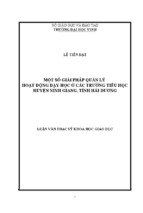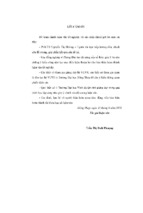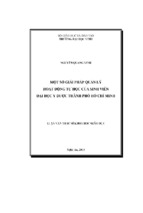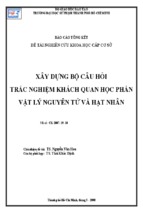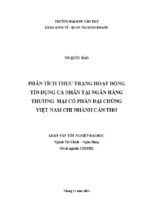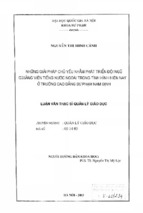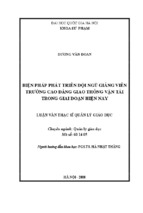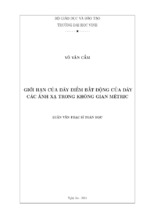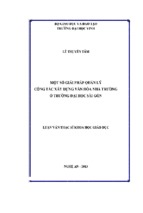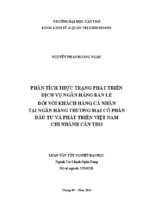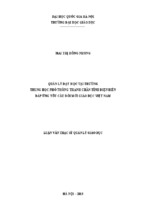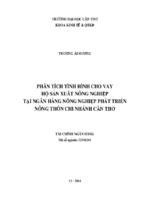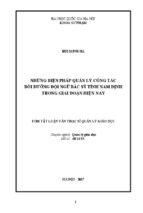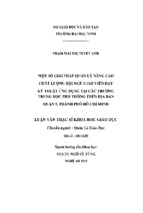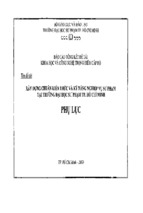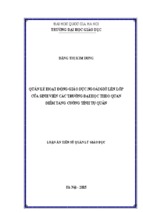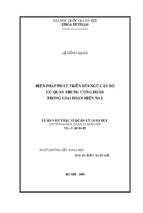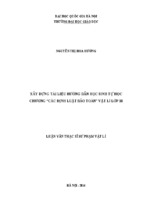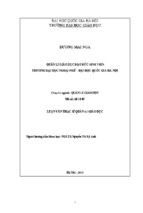1
2
MINISTRY OF EDUCATION AND TRAINING
UNIVERSITY OF DANANG
This thesis has been completed at the College of Foreign
Languages – the University of Danang
NGUYỄN THỊ MINH THƯ
Supervisor: Assoc. Prof. Dr. TRUONG VIEN
Examiner 1: Duong Bach Nhat, Ph. D.
AN INVESTIGATION INTO SYNTACTIC
AND SEMANTIC FEATURES
Examiner 2: Nguyen Thi Quynh Hoa, Ph. D.
OF IDIOMS DENOTING WORK
IN ENGLISH AND VIETNAMESE
The thesis was presented at the Examining Committee
Field: THE ENGLISH LANGUAGE
Code: 60.22.15
at the University of Danang
Time : 08 Jan 2012
Venue : University of Danang
M.A. THESIS IN THE ENGLISH LANGUAGE
(A Summary)
This thesis is available at:
•
The library of the College of Foreign Languages, the
University of Danang
DANANG – 2011
•
Information Resources Center, the University of Danang
3
4
CHAPTER 1
is called a plum job. That is what the above idiom wants to convey.
INTRODUCTION
1.1. RATIONALE
Or
"Clinton and Obama teaming up for the general election would
Language is considered as a system of communicating among
be a dream ticket for many Democrats”. In considering “dream
people who use sounds, symbols and words in expressing a meaning,
ticket”, what people want to mean this idiom is not dream or ticket.
idea or thought. This language can be used in many forms, primarily
Actually, this meaning is that two people who work well together and
through oral and written communications as well as using
be successful. Or
expressions through body language.
“Con trai tôi là niềm tự hào của cả nhà, cả họ, cùng với tiến bộ
Moreover, language is considered as a way to communicate
của nó trong sự học hành hi vọng trong lòng tôi cứ lớn dần, ñời nó sẽ
ideas comprehensibly from one person to another in such a way that
thoát ñược cái cảnh chân lấm tay bùn, một nắng hai sương, bán mặt
the other will be able to act exactly accordingly. And idiom is one of
cho ñất bán lưng cho trời, suốt ñời lẽo ñẽo theo sau ñít trâu cày và
the exciting and popular languagephenomenons.
tầm mắt chỉ thấy những gì quanh luỹ tre làng.(Huỳnh Văn Úc,2009)
Therefore, to learn a language, a person needs to learn the
Being aware of the importance of idioms in learning language
words in that language, and how and when to use them. But people
as well as in daily life, here and there, many researchers have
also need to learn idioms separately. And idioms reflect accumulated
investigated the syntactic and semantic features of idioms denoting
human experiences and are built on frequently occurring situations
the topics such as weather, money, body parts, animals, colours,
that demonstrate human behavior, social traits, certain habits or
causes and effects, verb of motion, etc. . .
tradition in a country. Every country or nation has got their own
idioms that are specific to their own culture, while many idioms have
synonyms in several countries what refers to the equal shared human
nature in many cultures.
Nevertheless, an investigation into idioms denoting work at
language levels has not been deal with so far.
For these reasons above, we would like to choose An
investigation into syntactic and semantic features of idioms
Every country or nation has got their own idioms that are
denoting work in English and Vietnamese for our thesis topic with
specific to their own culture, while many idioms have synonyms in
my desire to help language learners achieve correct comprehension
several countries what refers to the equal shared human nature in
of idioms.
many cultures. Learning the specific idioms reFor example,
1.2. RESEARCH SCOPE
"Ideally he'd like to find himself a plum job in New York." A
Due to the time and resource limitation, the thesis focuses on
desirable position which is well-paid and considered relatively easy
studying the syntactic and semantic features, analyzing data collected
6
5
from dictionaries in both languages: English and Vietnamese.
3. What are the similarities and differences between idioms
Besides, the data are also collected from English and Vietnamese
denoting work English and Vietnamese?
literature so that the research can provide a clearer and more
1.5. ORGANIZATION OF THE STUDY
interesting picture of idioms in context.
The study is organized into five chapters as follows:
1.3. AIMS AND OBJECTIVES
Chapter 1- Introduction
1.3.1. Aims
Chapter 2- Literature Review and the Theoretical Background
The study is expected to
Chapter 3- Methodology and Procedures
-
Investigate
some
syntactic,
semantic
and
cultural
characteristics of English and Vietnamese idioms denoting work.
Chapter 4- Findings and Discussion
Chapter 5- Conclusions and Implications
- Provide Vietnamese learners of English with a basic
knowledge of the field to help them use work idioms in listening,
speaking, reading, writing and especially, in translation
CHAPTER 2
LITERATURE REVIEW AND THEORETICAL
BACKGROUND
1.3.2. Objectives
The study is carried out to:
- Describe and compare some syntactic features of English and
Vietnamese work idioms.
- Describe and compare some semantic features of English and
Vietnamese work idioms.
2.1. LITERATURE REVIEW
The prosperity of language in form and content not only brings
the beauty of language but also deeply contributes to successful daily
communications. Every language in the world has large numbers of
idioms. Idioms make colour for language. Idioms carry a large
- Suggest some implications in order to help learners to
amount of nationally or culturally specific information with them. It
overcome their difficulties in dealing with English idioms denoting
can be said that idioms are an interesting and popular phenomenon of
work.
every language.
1.4. RESEARCH QUESTIONS AND HYPOTHESES
Up to now, there have been a number of writers making
The study attempt to seek answers to the following questions:
investigations into English and Vietnamese Idioms. There are many
1. What are the syntactic features of idioms denoting work in
dictionaries, books about idioms such as
English and Vietnamese?
2. What are the semantic features of idioms denoting work in
English and Vietnamese?
“Oxford Dictionary of
English Idioms”, by Cowie (1994), “Idioms Organizer”, by Wright.J
(1992), “ Idiom Structure in English” London by Strasler.J(1976) and
some ones written by Vietnamese authors such as “Từ ñiển thành ngữ
8
7
Anh - Việt" (Idioms Dictionary English - Vietnamese). Nhà xuất bản
According to Makkai [48] an idiom is “any polylexonic
Thành phố Hồ Chí Minh by Bùi Phụng (2000), "Thành ngữ tiếng
lexeme made up of more than one minimal free form of word (as
Việt", Nhà xuất bản Thanh niên by Nguyễn Lực (2001), "Sổ tay
defined by morphotactic criteria)”. Accordingly, idioms are units
thành ngữ tiếng Anh hiện ñại", Nhà xuất bản Trẻ by Nguyễn Thị
realized by at lease two words. In addition, “the meaning of an idiom
Tuyết-Trương Hùng,
is not predicted from its component parts, which are empty of their
Besides, there are also some dissertations of Vietnamese
learners about idioms such as Ngo Dinh Dieu Tam (2005), "A study
on English and Vietnamese idioms of comparison ", M.A thesis,
usual senses” [48, p.118].
Vietnamese linguistic researchers have given out a number of
definitions of idioms.
Danang University. In her thesis, she describes and analyzes the
Ho Le [14] states that “An idiom is a word combination which
syntactic and semantic features of English and Vietnamese idioms
has stable structure and figurative meaning and is used to describe an
containing comparison words. She gives out the similarities and
image, a phenomenon, a characteristic, or a state”.
differences in syntax and semantics fields of English and Vietnamese
To build a foundational for the study, we base on the above
comparison idioms
features as well as our observation. Then apply the following
2.2. THEORETICAL BACKGROUND
definition as the main reference for our research working: “an idiom
2.2.1. Definition of Idioms
is a fixed phrase which has integrity of meaning, making a complete
All languages have phrases and sentences that cannot be
referential unit whose meaning is different from the total meanings of
understood literally. Idioms are an interesting and popular
its components; it is non-literal and works as a single word”
phenomenon of every language. People cannot know idiomatic
2.2.2. Idioms Denoting Work
meaning simply by its structure and by using the standard lexical and
We often relate the world of work to make money. Working
syntactical rules to analyze it. So what is an idiom? How has it been
for money allows us to buy things we want. We also work because
defined by different linguists?
we are good at doing something, people need our skills or we enjoy
F.R.Palmer [56] said that idioms are consequences of words
being productive. So, what is work? According to The free
whose meaning cannot be predicted from the meaning of the words
Dictionary [74], work is defined as the physical or mental effort or
themselves. Semantically, idioms are single units, but they are not
activity directed towards the production or accomplishment of
single grammatical features and the problem of idioms involves the
something. Work is also defined as a job, a trade or other means of
much wider issue of word formation, by which what would appear to
livelihood. Besides, work means to carry on business, to be engages
be new and more complete lexemes can be formed from single ones.
or employed customarily.
9
10
Based on the definition of work above, we can say that idioms
2.2.4.2. Idioms and Collocations
denoting work are idioms consisting of employment and manner of
2.2.4.3. Idioms and Proverbs
work. For example, in Vietnamese, we have “Bán lưng cho trời”
2.2.5. Overview of Phrase Structures
denoting the typical job or “tham công tiếc việc” relates to the
2.2.5.1. Verb Phrases
manner of working. English idioms are “a bean- counter” or “work
2.2.5.2. Noun Phrases
one’s finger to the bone” in which people denote a particular job and
2.2.5.3. Adjective Phrases
a way of working. From the above definition of work, the following
2.2.5.4. Prepositional Phrases
features of work will be investigated:
2.2.6. Language and Culture Relationship
The work itself
Manner of work
2.2.6.1. Concept of Culture
2.2.6.2. The Relation of Culture and Language
Work
2.2.7. Summary
CHAPTER 3
Sense of responsibility
Workaholic
- The work itself, e.g. Buôn hưong bán phấn, Xướng ca vô
loài in Vietnamese and The rag trade in English.
- Manner of work, e.g., cổ cày vai bừa, cháy mặt lấm lưng or
up to one’s eyes, snowed under.
METHOD AND PROCEDURE
3.1. METHOD
This research is designed to meet the aims and objectives of
this study mentioned in Chapter I. In order to achieve this purpose, a
large number of idioms denoting work from many sources in English
- Sense of responsibility: Tận tâm tận lực, ñánh trống bỏ dùi..
and Vietnamese- have been collected and treated differently at
- Workaholic: Tham công tiếc việc or a glutton of work
various times. We have collected and analyzed data in order to find
2.2.3. Main Features of Idioms
out the differences and similarities in syntactic and semantic features
2.2.3.1. Structural Stability
between in English and Vietnamese. This study makes use of
2.2.3.2. Semantic Features
contrastive analysis in qualitative and quantitative approaches . 220
2.2.3.3. Semantic Ambiguity
English idioms and 220 Vietnamese idioms are collected for
2.2.3.4. Semantic Expressiveness
qualitative and quantitative analysis. Contrastive method helps us to
2.2.4. Idioms and Other Language Units
set up the similarities and differences in the way English and
2.2.4.1. Idioms and Phrases
11
12
Vietnamese people use the idioms denoting work in their daily
3.2.1 Data Collection
conversations as well as pieces of writing.
There are 220 English idiom samples denoting work and 220
Besides, descriptive research and contrastive research are
Vietnamese idiom samples denoting work. The data in the study is
chosen as the general methodology of the study. Descriptive research
collected from dictionaries, books, websites or examples used in
helps to describe and demonstrate linguistics features of idioms
contexts, in short stories, novels, newspapers and magazine in both
denoting work in English and Vietnamese. Typical examples and
English and Vietnamese
statistic tables of classification of idioms will be presented. Using the
3.2.2. Data Analysis
contrastive research, we aim to find out the similarities and
After finishing the collection of data from both languages, we
differences in syntax, semantics and cultural features of idioms in
start to use the qualitative and descriptive method to analyze, and
two languages. In addition, statistical and observation methods are
describe the syntactic and semantic features of idioms denoting
also applied to draw out necessary finds.
work.
3.2. RESEARCH PROCEDURE
3.3. SUMMARY
This research is carried out through the following steps:
(1) Collecting
English
and
Vietnamese
idioms
from
CHAPTER 4
dictionaries to reference and relevant materials, finding examples
which they are used.
(2) Using the view points of functional grammar by Halliday
to analyze English and Vietnamese idioms denoting work in term of
the contrastive analysis and to classify them in accordance with their
semantic and syntactic feature.
3) Finding and making a comparison and contrast between
structural mechanisms then semantic mechanisms of English and
Vietnamese idioms denoting work.
4) Showing the similarities and differences in term of
semantic characteristics between English and Vietnamese idioms
denoting work.
5) Suggesting possible ways of learning and teaching English
idioms denoting work.
FINDINGS AND DISCUSSION
4.1.
SYNTACTIC
FEATURES
OF
ENGLISH
AND
VIETNAMESE IDIOMS DENOTING WORK
4.1.1. Syntactical Glimpse at English and Vietnamese
Idioms Denoting Work
In this chapter, we focus on the syntactic and semantic
4.1.1.1. Noun Phrases
Let us take the following examples.
(1)- She has a free hand in choosing her staff.
[17, p.238]
(Article) + Adjective + Noun
(2)- He’s worked in the rag trade all his life.
(Article) + Noun + Noun
[17, p.563]
14
13
(3) - Any one can get to the top of the tree if they try hard enough
[17, p.753]
(Article) + Noun + Preposition + (Article) + Noun.
have been widely used in English more than in Vietnamese, which
can be summarized in table 4.1
Table 4.1 Noun Phrase Structures of English and Vietnamese
(4) - Being accepted by the college was a mixed blessing, since she
couldn’t afford the tuition.
Idioms Denoting Work
[29, p.423]
English
(Article) + Past Participle + Noun
[ 1] ( Article) + Adjective + Noun [1] Noun+ Adj. + Noun + Adj
The sports shop is doing a roaring trade in bicycles these days.
[72.p.10]
(Article) + Present Participle + Noun
(6) - Jane likes to have a finger in every pie
[17, p.216]
(Article) + Noun + Prepositional Phrase
In comparison with English idioms, Vietnamese also owns
[2] (Article) + Noun + Noun
Noun phrases
(5)
population of idioms forming in this phrase is limited and will be
[3] (Article)+ Noun + Preposition [3] Numeral+ Noun/ Numeral
+ (Article) + Noun
+ Noun
[4] (Article) + Past Participle +
Noun
[5] (Article) + Present Participle
+ Noun
presented in the following struct
Hết năm ấy sang năm khác, vợ chồng ñầu tắt mặt tối, không
[6]
dám chơi không ngày nào.
Prepositional Phrase
4.1.1.2. Verb Phrases
[26, p.296]
Noun + Adjective + Noun + Adjective
(8)
Thím Hai lúc nào cũng miệng nói tay làm, ñi gót không bắn
ñất, ngồi chưa ấm chỗ ñã dậy.
[26, p.453]
(Article)
+
Noun
+
(10) It takes me a couple of weeks to learn the ropes but after that I
should be fine.
[17, p.593]
Verb + Noun/ Noun phrase
Noun + Verb + Noun + Verb
(11) The government minister fell from grace as a result of the
Let us have a look at the example below
(9) – Mặc dầu bận trăm công nghìn việc, hằng ngày Bác vẫn quan
tâm săn sóc thiếu niên nhi ñồng.
[2] Noun + Verb + Noun +
Verb
some idioms denoting work in form of noun phrase. However, the
(7)
Vietnamese
[3, p.303]
Numeral + Noun / Numeral + Noun
financial scandal.
Verb + Preposition + Noun Phrase
(12) She’s working her fingers to the bone to support her children.
[28, p.722]
In short, we have just looked into the syntactic features of
English and Vietnamese noun phrase. We can see that work idioms
[1, p.96]
Verb + Noun + Prepositional phrase
16
15
(13) George went to Washington and brought home the bacon.
Verb + Noun + Prepositional Noun.
[28, p.82]
English and Vietnamese idioms denoting work contribute to
Verb + Noun + Noun
form verb phrases in large number. The verb phrase structures in
Vietnamese idioms verb phrases will be analyzed under the
both languages can be summed up in the table 4.2 below
following structures: Verb + Noun/ Noun phrase, Verb + Adjective,
Table 4.2. Verb Phrase Structures of English and Vietnamese
Verb + Prepositional phrase, Verb + Như + Noun phrase.
Denoting Work
Let’s look at these examples:
English
(14) Hai mươi năm trước, mẹ anh ñã tất tả khuya sớm buôn thúng
[26,p.94]
Verb + Noun/ Noun Phrase + Verb + Noun/ Noun Phrase
(15) Chẳng hạn, những nguời phụ nữ quen cày sâu cuốc bẫm rời
nông thôn về thành phố theo chồng ñi lính và từ người trực
tiếp sản xuất bỗng chốc trở thành những kẻ sống bám chỉ biết
ñẻ con, người ñảm lắm là biết bán buôn lặt vặt.
Verb Phrases
bán mẹt kiếm từng xu rau cháo lần hồi nuôi Kì khôn lớn.
[1] Verb + Noun/ NP
[1] Verb + Noun /NP
[2] Verb + Preposition +
[2] Verb + Adjective +
Noun Phrase
Verb + Adjective
[3] Verb + Noun + Prepositional [3] Verb + Noun +
Phrase
Prepositional Phrase
[4] Verb + Noun + Noun
[4] Verb + Như + Noun
Phrase
[18, p.113]
[5] Verb + Noun/ NP +
Verb + Adjective + Verb + Adjective
Verb + Noun/NP
(16) Xóm làng ñang vui, ñang dự tính tiến hành bao nhiêu công
chuyện, chúng nó ngang nhiên thọc gậy bánh xe.
Vietnamese
[3, p.63]
4.1.1.3. Adjective Phrases
(19) Bob’s busy as a beaver trying to finish painting before it rains.
Verb + Noun/ Noun Phrase
[28, p.91]
(17) Con bảo rằng: Ông Ba Xúc ạ, nghề trồng rau thì ông sành sỏi
lắm, chả thế mà vườn rau riêng lại tốt nhất vùng này. Khi vun
Adjective + Preposition + Noun Phrase
xới vườn rau chung thì ông sợ mỏi tay, thương hòn ñất nên
Different from the English adjective phrases, Vietnamese ones
làm như mèo mửa.
[26, p.408]
occupy a large number in this form.
(20) Bao nhiêu công việc ñổ cả lên ñầu Keng. Anh bận tối mặt tối
Verb + Như + Noun Phrase
(18) Có người còn góp ý là cứ nhượng cho các xí nghiệp dân sự ñể
mũi, mười giờ ñêm vẫn còn ở sân phơi.
họ làm, vừa gọn tay mà vẫn có tiền, tội gì mà ôm rơm cho rặm
Adjective + Noun + Adjective + Noun
bụng.
[26, p.542]
[26, p.649]
17
18
(21) Chí Phèo không là anh hùng, nhưng nó là cái thằng liều lĩnh.
(23) So, I’m going to spend the whole weekend painting the outside
Liều lĩnh thì còn ai thèm chấp! Thế nào là mềm rắn nắn buông?
of the house. Do you want some help? My boyfriend’s so I’m
Cái nghề làm việc quan, nếu nhất nhất cái gì cũng ñè ñầuấn cổ
at a loose end
thì lại bán nhà ñi cho sớm.
Preposition + ( Article) + Adjective + Noun
[ 64, p.71]
Adjective +Verb + Adjective + Verb
(24) I’m up to my ears in work
(22) Cái thằng Triều lười như hủi nói như trạng mẹ, trông thấy cái
tay nó nghều ngào mà phát ghét.
[16, p.377]
(25) It’s going to be a busy year of us. We’ve got two major projects
Verb + Như + Noun/ Noun Phrase
to finish and an even bigger in the pineline.
The table 4.3 below will show the general use of adjective
Preposition + Noun Phrase
denoting work can be illustrated in the table 4.4
Vietnamese Idioms Denoting Work
Noun Phrase
Table 4.4. Prepositional Phrase Structures of English and
Vietnamese Idioms Denoting Work
Vietnamese
[1] Adjective + Noun +
Adjective + Noun
[2] Adjective + Verb ,
Adjective + Verb
[3] Adjective + Như + Noun
Phrase
Prepositional phrases
Adjective phrases
[1] Adjective + Preposition +
[42, p.180]
The prepositional phrases in both English and Vietnamese
Table 4.3. Adjective Phrase Structures of English and
English
[29, p.693]
Preposition + Prepositional phrase
phrase in English and Vietnamese denoting work.
Adjective Phrases
[41, p.178]
English
[1] Preposition + ( Article) + Adjective + Noun
Vietnamese
_
[2] Preposition + Prepositional phrase
[3] Preposition + Noun Phrase
4.1.1.4. Prepositional Phrases
According to Diep Quang ban, preposition in Vietnamese is
not a main part of speech and prepositional phrase is not typical. As
a result, prepositional phrase in this corpus do not contain any
4.1.1.5. Adverb Phrases
(26) Nhìn thấy công trường ta cũng thấy rỏ, tuy có một vài sáng
kiến cải tiến kỹ thuật thật ñấy, nhưng bất quá như muối bỏ bể.
idioms in Vietnamese, just in English.
[26, p.519]
Adverb + Noun + Verb Phrase
19
20
Table 4.5. Adverb Phrase Structures of English and Vietnamese
English and Vietnamese idioms denoting work rank the similar
Idioms Denoting Work
Adverb
ENGLISH
proportion in forming Noun phrases 23.2% versus 22.7%. Secondly
There is a total of 129 idioms in form of Verb phrases in
VIETNAMESE
Phrase
[1]- Adverb + Noun + Verb Phrase
English, accounting for 58.6%. Vietnamese idioms contributing to
this field are 125 idioms, accounting for 56.8%. Next, the percentage
Table 4.7 A Statistical Summary of Syntactic Features of English
of Adjective phrases in English idioms denoting work is lower than
and Vietnamese Idioms Denoting Work
in Vietnamese idioms denoting work is 18.2% compared with 2.7%.
Then, there is a significant difference in the percentage of
English
English and
Vietnamese idioms
denoting work
Vietnamese
Prepositional phrases in English and Vietnamese idioms that is 9%
in compared with 0%. Finally, Vietnamese people use more phrases
Number Percentage Number Percentage
with 5 idioms accounting for 2.3%. Meanwhile, we do not find any
Adverb phrases in English. The result of Prepositional phrases and
Noun Phrases
Adverb phrases are a complete contrary.
51
23.2%
50
22.7%
4.2.
SEMANTIC
FEATURES
OF
ENGLISH
AND
VIETNAMSE IDIOMS DENOTING WORK
Syntactical Analysis
Verb Phrases
129
58.6%
125
56.8%
4.2.1.
Transference
of
Meaning
of
English
and
Vietnamese Idioms Denoting Work
Adjective Phrases
6
2.7%
40
18.2%
The meaning of idioms cannot be determined just by looking
at or understanding the meaning of the components in isolation, we
had better obtain the relationship between the connotative and
Prepositional
Phrases
34
Adverb Phrases
0
0
5
2.3%
220
100%
220
100%
Total
15.5%
0
0%
denotative meaning of the components to predict the idiomatic
meanings. English and Vietanamese idioms denoting work have a
very high symbolic characteristic since most of them use some main
popular principles of meaning transfer as follows:
4.2.1.1. Metaphor
The table shows the numbers and percentages of English and
4.2.1.2. Metonymy
Vietnamese idioms denoting work in the syntactic features. Firstly,
4.2.1.3. Hyperbole
21
22
4.2.1.4. Simile
Table 4.8. Table 4.8 Frequency of Semantic Fields of English and
4.2.1.5. Symmetry
4.2.2. Semantics Fields of English and Vietnamese Idioms
Vietnamese Idioms Denoting Work
English and Vietnamese Idioms
Denoting Work
Denoting Work
English
Vietnamese
Number Percent Number Percent
1
Hiring and Firing
26
11.8%
2
0.9%
4.2.2.2. Success and Failure
2
Success and Failure
17
7.7%
18
8.2%
3
Employment and
11
5.0%
17
7.7%
4.2.2.3. Employment and Unemployment
4.2.2.4. Strenuousness
4.2.2.5. Diligence/ Laziness
4.2.2.6. Behaviors and Attitudes
4.2.2.7. Advantages and Disadvantages
4.2.2.8. Power and Powerlessness
4.2.2.9. Responsibility
4.2.2.10. Solidarity
4.2.2.11. Workaholic
4.2.2.12.Uselessness
Figurative Characteristics of English and
Vietnamese denoting work
4.2.2.1. Hiring - Firing
Unemployment
4
Strenuousness
35
14.6%
60
27.2%
5
Diligence/Laziness
17
7.7%
26
11.8%
6
Behaviors and Attitudes
37
16.8%
25
11.3%
7
Advantages/Disadvantages
29
13.5%
25
11.3%
8
Power/ Powerlessness
10
4.9%
14
6.3%
9
Responsibility
15
6.9%
7
3.5%
10
Solidarity
7
3.5%
8
3.6%
11
Workaholic
3
1.5%
5
2.3%
12
Uselessness
4
1.8%
11
5%
13
Others
9
4.5%
2
0.9%
220
100%
220
100%
Total
4.2.3. National Characteristics of Idioms Denoting Work in
English and Vietnamese
It is undeniable that national characteristic is common in
languages. This feature is expressed in idioms in general and in idioms
denoting work in particular.
As discussed previously, idioms denoting work refect vividly of
events and phenomena. In addition, each nation has its own style of
23
24
living, experience, and customs. Therefore, they have their own ways
CHAPTER 5
of recording events or phenomena which happening around them.
Hence, they reflect what they perceive differently and use some
images as “symbols” in their contents.
CONCLUSIONS - IMPLICATIONS AND LIMITATIONS
5.1. CONCLUSIONS
The ultimate purpose of this study was to point out the
4.2.3.1. Cultural Symbols
syntactic and semantic features of idioms denoting work in Enlgish
4.2.3.2. Symbolic Animals
and Vietnamese. By doing this, we aim to find out the various
4.2.3.3. Human Body Parts
meanings as well as the constructions possessed by idioms denoting
4.2.4. Similarities and Differences In Semantic Features of
work and the way it is used properly in both languages.
Idioms Denoting Work
Semantically, English and Vietnamese idioms denoting work
4.2.4.1. Similarities
express their meaning via semantic transfer as metaphor, metonymy,
4.2.4.2. Differences
hyperbole and simile.
Syntactically, idioms are analyzed under the phrasal structures
which are categorized into noun phrases, verb phrases, adjective
phrases, preposition phrases in English and Vietnamese idioms are
under noun phrases, verb phrases, adjective phrases, adverb phrases.
Besides, we can group English and Vietnamese idioms denoting
work into three kinds of grammatical features in relation to semantic
mechanism. They are symmentry structure, comparative structure
and metaphorically descriptive structure
Chapter 1 presents the rationale of the study and states what
the study is aimed at. Also, the research questions, scope of the study
and methods of the study are included.
Chapter 2 provides a review of related previous studies,
fundamental and essential theoretical preliminaries concerning the
subject under discussion in the following chapter.
Chapter 3 is designed to describe the methods and procedures
of this paper
25
Chapter 4 presents the findings and discussion of the research
26
5.3. LIMITATIONS OF THE STUDY AND SUGGESTIONS
where the semantics and syntactic characteristics of English denoting
FOR FURTHER RESEARCHES
work and Vietnamese denoting work are in focus.
There is no denying that this paper cannot cover all
Chapter 5 designs conclusions on syntactic, semantic and
constructions as well as all meanings of English and Vietnamese
gives some suggestions for the Vietnamese teachers as well as
idioms denoting work under discussion because of the limitation of
learners in teaching and learning idioms denoting work.
time and reference materials, as well as the constraints faced by the
5.2. IMPLICATIONS FOR LANGUAGE TEACHING
researcher, therefore there are still areas for further studies such as
Idioms are widely used in our life by the native speakers, which
may become an obstacle in commucation if they do not know what the
speakers means through idioms.
In order to help Vietnamese learners of English to overcome
the above obstacle, we’d like to give some suggestions for language
teaching and learning.
(1) Idioms should be introduced to languages learners at all
levels.
(2) The learners should be encouraged to use idioms to improve
their communicative skill especially in speaking and in writing.
(3) Different coursebooks, dictionaries and other resources
should be used to examine the correctness of idioms.
(4) The teachers should be sensible in dealing with cultural
differences to have more precise explanation for the learners.
(5) We cannot teach a foreign language without teaching
idioms, since they are not a separete part of the language, which we
choose either to use or to omit. To use idioms effectively, one not
only has the basic knowledge of language but also has to know about
culture, beliefs or knowledge of mental states (interests, goals,
opinions). This is considered as barriers in their language acquisition.
- English and Vietnamese Proverbs Denoting Work
- An investigation into Cultural Aspects of English and
Vietnamese Idioms Denoting Work.
- Xem thêm -

